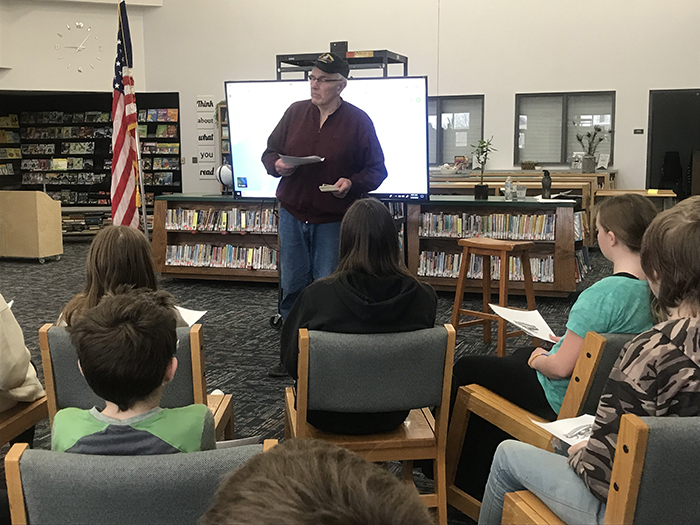A real-life lesson on Vietnam War
News | Published on April 12, 2022 at 5:17pm EDT | Author: Chad Koenen
0Stueve visits with students about serving in the military

Dave Stueve visited with Henning School sixth, seventh and ninth graders on March 29 in recognition of Vietnam War Veterans Recognition Day.
By Chad Koenen
Publisher
The Vietnam War recently came to life thanks to a familiar face at Henning School.
Dave Stueve, who is a longtime bus driver at Henning School, shared his experience and pictures from his time in the Vietnam War with Henning sixth, seventh and ninth grade students on March 29. The day brings an extra special importance to Vietnam veterans like Stueve, as a 2017 act of congress marked the day as National Vietnam War Veterans Recognition Day. The recognition comes 44 years after the final combat troops departed Vietnam on March 29, 1973.
Over the years Stueve, who was a mechanic in the Navy and served in Vietnam in 1969, has offered to speak to classes at Henning School about his experience in the Vietnam War. Though the end-of-the-year schedule hadn’t worked out in the past, this year he reached out to science teacher Dana Damm. Not only did Damm take him up on the offer to speak to one class, but soon Stueve found himself in front of all of the sixth, seventh and ninth graders on March 29.
“He said do you have three hours. It seemed like every one of (the classes) was a little bit different.”
Dave Stueve on taking Dana Damm’s offer
The Vietnam War was fought between North and South Vietnam from 1954-75. A total of 2.7 million American troops were sent to South Vietnam during the war, while South Vietnam supplied a total of 942,000 troops. The Viet Cong amassed an estimated 2.3 million troops by 1975. Much of the war was fought in dense jungle terrain, so the American military developed a chemical solution known as Agent Orange to burn through the brush and lure out the hiding Viet Cong forces.
While Agent Orange was effective at its job, side effects occurred because of the product. Around half a million Vietnamese children were born with birth defects because of its use and American soldiers and their families have reported side effects from being exposed to the chemical.
The United States lost 58,220 known military personnel during the war. Being killed in action was the leading cause of American casualties. It is estimated South Vietnam lost between 200,000 and 250,000 fighters and the Viet Cong lost around 1.1 million combatants. Around 2 million individuals were killed in the territories of North and South Vietnam, Laos and Cambodia during the war, a majority of them were murders.
During his time in the military, Stueve served as a mechanic in the Navy. Though he was in the Navy, Stueve said he was never on a ship, instead, he built roads.
While Stueve said he was welcomed back to the Henning area following his service, that wasn’t the case when they landed in California as protesters lined the streets to express their displeasure with the war.
Part of his message was to not only share his experience about the war, but to let the students know how important it is to thank a veteran who served in the military, whether that be in Vietnam, Korea, Desert Storm or any other past conflict. Stueve shared one story in which a 6-year-old in Walmart came up to him one day and thanked him for his service.
Stueve enjoyed the opportunity to share his story about serving in the military and visit with the students throughout the day.
“It was fun I enjoyed it,” he said.
